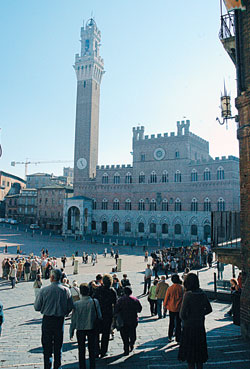Vacation/Travel Supplement
Italian artistry:
Beauty fills Tuscany’s cities, towns and countryside

Tourists and townspeople gather at Siena’s Piazza del Campo, where its famous horse race, the Palio, is run twice a year. The Italian city’s medieval town hall, the Palazzo Pubblico, dominates the plaza with its tall clock tower.
(Photo by Sean Gallagher)
By Sean Gallagher
TUSCANY, ITALY—The cities and towns of Tuscany, a region of Italy north and west of Rome, attract countless visitors, filled as they are with beautiful, centuries-old churches and museums.
Traveling through the region—at least for this two-time visitor to Tuscany—also keeps tourists charmed with every hill and turn in the road.
The rolling hills of Tuscany, which are the foothills of the Apennine Mountains, make up a beautiful patchwork quilt dotted with trees, villas, vineyards and olive tree groves.
If you haven’t had the chance to travel through Tuscany, you can get a visual taste for what the region looks like by viewing the 1993 Shakespearean movie Much Ado About Nothing.
But as beautiful as that movie is visually, it cannot compare with actually visiting the region.
The splendor of the Tuscan hills is complemented nicely by the magnificence seen in its cities and towns.
The most prominent city in Tuscany is Florence.
Even as a green, first-time overseas traveler of 17 when I visited the city 20 years ago, I found it easy to navigate its streets because of the Arno River that flows through the city.
As you walk from place to place, simply keep in mind where the river is located and that will help keep you from getting lost.
Walking near the river itself is a treat with the many interesting and ancient bridges that cross it.
The most well-known of these is the medieval Ponte Vecchio, on which have been built lines of shops over the centuries. Today, the buildings are mostly jewelry shops and art galleries.
A visit to Florence would not be complete without stopping at the city’s cathedral, known in Italian as the “Duomo.” The Renaissance era dome designed by Brunelleschi dominates the skyline of the magnificent city.
The baptistry across the street from the duomo is also a great tourist site with its beautiful gilded bronze doors, known as the “Gates of Paradise,” and a 13th-century mosaic of the Last Judgment which adorns its ceilings.
One can easily imagine the medieval Florentine poet Dante being inspired by the mosaic as he penned the “Inferno” section of his Divine Comedy.
Florence’s two great museums, the Academia and the Pitti Palace, are great meccas for lovers of Renaissance sculptures and paintings because they are filled with great works of art by Michelangelo, Raphael and other noted artisans.
Michelangelo’s famous statue of David is housed in a beautiful gallery in the Academia.
Another prominent city in Tuscany is Siena. Like Florence, the view of Siena is dominated by its stunning medieval cathedral, covered on the exterior and interior with alternating rows of black and white marble.
The Church of San Domenico in Siena houses relics of the city’s great saint, Catherine of Siena, who is also patroness of all of Italy.
Siena’s Church of San Franceso is the site of a Eucharistic miracle. Consecrated hosts that date from 1730 remain in pristine condition.
Before leaving Siena, visitors should take some time to relax on its main square, the Piazza del Campo.
This large plaza is surrounded by tall apartment buildings that house shops and restaurants on their ground floors. It slopes downward to the Palazzo Pubblico, Siena’s medieval town hall, which dominates the area with its tall clock tower.
Most of the time, visitors and residents of Siena will sit back and relax in the square, perhaps enjoying some delicious gelato—Italian ice cream—as I did when visiting Siena in 2006.
But on July 2 and Aug. 16 each year, the Piazza del Campo is packed with spectators for the city’s centuries-old bareback horse race, the Palio.
Neighborhoods in the city sponsor horses, and the event is known for secret negotiations that begin well in advance. Residents of various neighborhoods team up to help each other or block their rivals’ horses.
The riders’ whips can be used on their competitors as well as on their own horses.
The race is preceded by a great medieval pageant with men in flowing, colorful costumes waving large, equally colorful flags that represent the neighborhoods.
If visitors to Tuscany happen to be in Siena on the day of the running of a Palio, they might want to escape the loud, bustling crowd gathered for the race by retreating to the quiet, hilltop town of San Gimignano.
An American tourist new to San Gimignano might be surprised when approaching the town because its skyline, which is medieval in origin, resembles in some ways a modern American city dominated by tall skyscrapers.
San Gimignano is home to some 14 tall towers built by families in the town during the Middle Ages. Much like large corporations of today, families back then sought to display their prestige by building towers on their homes that were bigger than their rivals.
Other Tuscan cities and towns at one time featured such towers, but most of these structures have been brought down through wars or other disasters.
Beauty will welcome you at every turn in Tuscany, and you will want to return again and again. †
